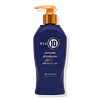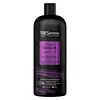What's inside
What's inside
 Key Ingredients
Key Ingredients

No key ingredients
 Benefits
Benefits

 Concerns
Concerns

 Ingredients Side-by-side
Ingredients Side-by-side

Cyclopentasiloxane
EmollientDimethiconol
EmollientHydrolyzed Keratin
HumectantPrunus Amygdalus Dulcis Oil
Skin ConditioningMauritia Flexuosa Fruit Oil
Skin ConditioningCinnamidopropyltrimonium Chloride
Argania Spinosa Kernel Oil
EmollientIsohexadecane
EmollientAlpha-Isomethyl Ionone
PerfumingPolysilicone-15
UV FilterKeratin Amino Acids
Skin ConditioningOenothera Biennis Oil
EmollientSesamum Indicum Seed Oil
EmollientParfum
MaskingLinalool
PerfumingHexyl Cinnamal
PerfumingButylphenyl Methylpropional
PerfumingHydroxyisohexyl 3-Cyclohexene Carboxaldehyde
MaskingCitronellol
PerfumingLimonene
PerfumingBenzyl Benzoate
AntimicrobialCyclopentasiloxane, Dimethiconol, Hydrolyzed Keratin, Prunus Amygdalus Dulcis Oil, Mauritia Flexuosa Fruit Oil, Cinnamidopropyltrimonium Chloride, Argania Spinosa Kernel Oil, Isohexadecane, Alpha-Isomethyl Ionone, Polysilicone-15, Keratin Amino Acids, Oenothera Biennis Oil, Sesamum Indicum Seed Oil, Parfum, Linalool, Hexyl Cinnamal, Butylphenyl Methylpropional, Hydroxyisohexyl 3-Cyclohexene Carboxaldehyde, Citronellol, Limonene, Benzyl Benzoate
Water
Skin ConditioningSodium C12-13 Pareth Sulfate
CleansingCocamidopropyl Betaine
CleansingGlycerin
HumectantSodium Chloride
MaskingCeramide Ng
Skin ConditioningArginine
MaskingLysine Hcl
Skin ConditioningHydrolyzed Keratin
HumectantDimethiconol
EmollientParfum
MaskingCitric Acid
BufferingGlycol Distearate
EmollientCarbomer
Emulsion StabilisingGluconolactone
Skin ConditioningSodium Benzoate
MaskingSodium Laureth Sulfate
CleansingTea-Dodecylbenzenesulfonate
CleansingPPG-9
Skin ConditioningCocamide Mea
EmulsifyingSodium Sulfate
Guar Hydroxypropyltrimonium Chloride
Skin ConditioningTrehalose
HumectantDisodium EDTA
PEG-45m
HumectantBenzyl Alcohol
PerfumingBenzyl Salicylate
PerfumingHexyl Cinnamal
PerfumingLimonene
PerfumingLinalool
PerfumingMica
Cosmetic ColorantCI 77891
Cosmetic ColorantWater, Sodium C12-13 Pareth Sulfate, Cocamidopropyl Betaine, Glycerin, Sodium Chloride, Ceramide Ng, Arginine, Lysine Hcl, Hydrolyzed Keratin, Dimethiconol, Parfum, Citric Acid, Glycol Distearate, Carbomer, Gluconolactone, Sodium Benzoate, Sodium Laureth Sulfate, Tea-Dodecylbenzenesulfonate, PPG-9, Cocamide Mea, Sodium Sulfate, Guar Hydroxypropyltrimonium Chloride, Trehalose, Disodium EDTA, PEG-45m, Benzyl Alcohol, Benzyl Salicylate, Hexyl Cinnamal, Limonene, Linalool, Mica, CI 77891
 Reviews
Reviews

Alternatives
Ingredients Explained
These ingredients are found in both products.
Ingredients higher up in an ingredient list are typically present in a larger amount.
Dimethiconol is a silicone that resembles the popular dimethicone. Like other silicones, it is an emollient. Emollients create a thin film on skin to prevent moisture from escaping.
This ingredient helps to create a silky texture and improve spreadability. Due to its high molecular weight and thickness, it is often combined with cyclopentasiloxane.
Hexyl Cinnamal is a fragrance ingredient with a similar scent to jasmine. It can be naturally found in chamomile essential oil.
This ingredient is a known EU allergen and may sensitize the skin. The EU requires this ingredient to be listed separately on an ingredients list.
Hexyl Cinnamal is not water soluble but is soluble in oils.
Learn more about Hexyl CinnamalHydrolyzed Keratin is derived from keratin. Keratin is a large protein that is naturally found in our hair and skin.
Studies show keratin is able to seal broken hair cuticles, helping to prevent split ends and breakage.
As a humectant, hydrolyzed keratin helps draw moisture from the air to your hair and skin. This helps keep your skin and hair hydrated.
Learn more about Hydrolyzed KeratinLimonene is a fragrance that adds scent and taste to a formulation.
It's found in the peel oil of citrus fruits and other plants such as lavender and eucalyptus. The scent of limonene is generally described as "sweet citrus".
Limonene acts as an antioxidant, meaning it helps neutralize free radicals.
When exposed to air, oxidized limonene may sensitize the skin. Because of this, limonene is often avoided by people with sensitive skin.
The term 'fragrance' is not regulated in many countries. In many cases, it is up to the brand to define this term. For instance, many brands choose to label themselves as "fragrance-free" because they are not using synthetic fragrances. However, their products may still contain ingredients such as essential oils that are considered a fragrance.
Learn more about LimoneneLinalool is a fragrance and helps add scent to products. It's derived from common plants such as cinnamon, mint, citrus, and lavender.
Like Limonene, this ingredient oxidizes when exposed to air. Oxidized linalool can cause allergies and skin sensitivity.
This ingredient has a scent that is floral, spicy tropical, and citrus-like.
Learn more about LinaloolParfum is a catch-all term for an ingredient or more that is used to give a scent to products.
Also called "fragrance", this ingredient can be a blend of hundreds of chemicals or plant oils. This means every product with "fragrance" or "parfum" in the ingredients list is a different mixture.
For instance, Habanolide is a proprietary trade name for a specific aroma chemical. When used as a fragrance ingredient in cosmetics, most aroma chemicals fall under the broad labeling category of “FRAGRANCE” or “PARFUM” according to EU and US regulations.
The term 'parfum' or 'fragrance' is not regulated in many countries. In many cases, it is up to the brand to define this term.
For instance, many brands choose to label themselves as "fragrance-free" because they are not using synthetic fragrances. However, their products may still contain ingredients such as essential oils that are considered a fragrance by INCI standards.
One example is Calendula flower extract. Calendula is an essential oil that still imparts a scent or 'fragrance'.
Depending on the blend, the ingredients in the mixture can cause allergies and sensitivities on the skin. Some ingredients that are known EU allergens include linalool and citronellol.
Parfum can also be used to mask or cover an unpleasant scent.
The bottom line is: not all fragrances/parfum/ingredients are created equally. If you are worried about fragrances, we recommend taking a closer look at an ingredient. And of course, we always recommend speaking with a professional.
Learn more about Parfum